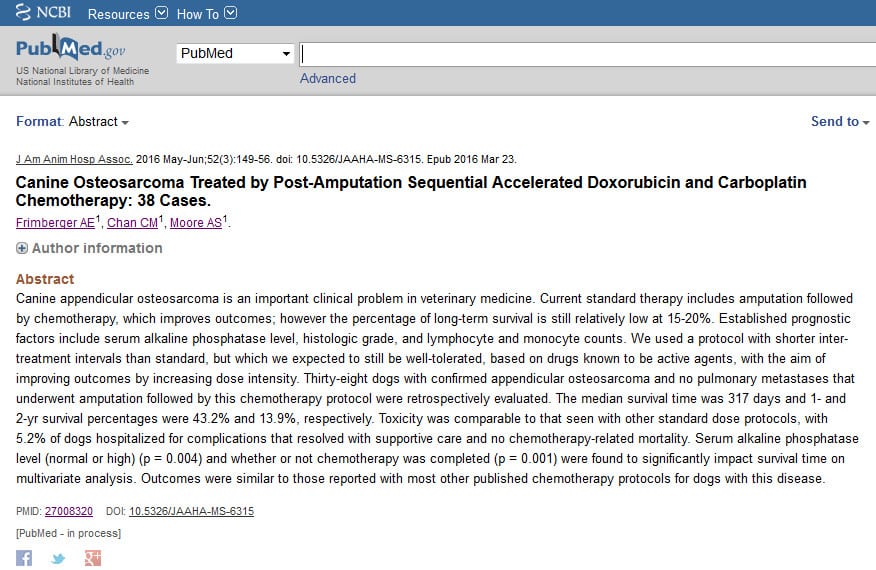Sometimes it seems that the fight against pet cancer isn’t making any progress. The good news is that every day, veterinary oncologists are studying new and better ways to treat – even eradicate! – pet cancer. One of these heroes is Dr. Angela Frimberger, VMD, Diplomate ACVIM (Oncology) of Veterinary Oncology Consultants (VOC), a resource for veterinarians only. She recently studied the outcomes of dogs who went on accelerated chemotherapy intervals for canine osteosarcoma.

Dr. Frimberger and her team at the Australia-based VOC work directly with veterinarians by making evidence- and compassion-based recommendations for pets with cancer. One way they do that is by investigating innovative treatments. As an example, Dr. Frimberger recently published an interesting study called “Canine Osteosarcoma Treated by Post-Amputation Sequential Accelerated Doxorubicin and Carboplatin Chemotherapy.”

This study caught our attention because it examined whether osteosarcoma outcomes could be improved by accelerating the chemotherapy schedule for treating osteosarcoma with doxorubicin and carboplatin.
We selected highlights from the study’s abstract and asked Dr. Frimberger if she could explain each one in laypersons terms. We’re thrilled she agreed and hope you find her work as fascinating as we do.
Can Shorter Chemotherapy Intervals for Canine Osteosarcoma Improve Survival Times?
“Abstract: Canine Osteosarcoma Treated by Post-Amputation Sequential Accelerated Doxorubicin and Carboplatin Chemotherapy: 38 Cases.
Frimberger AE1, Chan CM1, Moore AS1.
Canine appendicular osteosarcoma is an important clinical problem in veterinary medicine. Current standard therapy includes amputation followed by chemotherapy, which improves outcomes; however the percentage of long-term survival is still relatively low at 15-20%.
Established prognostic factors include serum alkaline phosphatase level, histologic grade, and lymphocyte and monocyte counts. We used a protocol with shorter inter-treatment intervals than standard, but which we expected to still be well-tolerated, based on drugs known to be active agents, with the aim of improving outcomes by increasing dose intensity.
Thirty-eight dogs with confirmed appendicular osteosarcoma and no pulmonary metastases that underwent amputation followed by this chemotherapy protocol were retrospectively evaluated. The median survival time was 317 days and 1- and 2-yr survival percentages were 43.2% and 13.9%, respectively. Toxicity was comparable to that seen with other standard dose protocols, with 5.2% of dogs hospitalized for complications that resolved with supportive care and no chemotherapy-related mortality. Serum alkaline phosphatase level (normal or high) (p = 0.004) and whether or not chemotherapy was completed (p = 0.001) were found to significantly impact survival time on multivariate analysis.
Outcomes were similar to those reported with most other published chemotherapy protocols for dogs with this disease.” (from PubMed.gov)
Putting it into Pet Parent Language
Dr. Frimberger: “I should tell you right up front, my results weren’t particularly spectacular. There are some investigators who feel the need to always claim they got the “best” results ever. I believe that’s not how science works and what we need to do is publish whenever we learn anything, whether it’s the “best ever” or not, because that’s how we really build knowledge. To me, publishing a study is not about me being anything special, it’s making a contribution to the literature so we can all work together toward progress. OK, having said that . . . ”
Tripawds Asks: How short? And in what order was the doxorubicin and carboplatin administered? Rotating? Or all doxorubicin for the first phase, then all carboplatin for the next?
Dr. Frimberger: “We used all standard doses of standard drugs, and a standard number of cycles. One of the most established protocols for osteosarcoma, as you probably know, is 3 cycles of doxorubicin and 3 cycles of carboplatin alternating at 3-week intervals. We gave all the doxorubicin first, then gave all the carboplatin. The inter-treatment intervals in the doxorubicin phase were shorted by 33%, from 3 weeks to 2 weeks. So, it cut a total of 3 weeks off the total protocol duration (16%) from 19 weeks to 16 weeks (including 3 weeks recovering time from the last treatment) compared to the older / more typical type of scheduling.”
Tripawds Asks: How did it compare to the usual dosages given for these drugs?
Dr. Frimberger: “The actual doses we used were standard, but we accelerated the schedule. Dose intensity is a concept in chemotherapy, where we look at not only individual doses of drugs, but dose over time. It is commonly measured in mg/m2 per week. It is pretty well understood that dose intensity is a determinant of outcome (i.e. higher dose intensity = better cancer control) in various cancers in people, and there is some evidence that the same is true in dogs.
Since dose intensity is dose over time, the 2 ways to modify it are by changing the dose, and by changing the time. For both doxorubicin and carboplatin, the standard doses are pretty much as high as we can go without risking undue toxicity; so that leaves time as the variable that we could work with. Carboplatin pretty much does require a 3-week interval, but what we had found was that the traditional 3-week interval after doxorubicin was really unnecessarily long; and that was the key that allowed us to accelerate the schedule without increasing toxicity.
So, we increased the dose intensity by 16%, which is not a huge leap but it’s significant, especially with such a simple and well tolerated alteration to the standard approach.”
Tripawds Asks: How does this compare to typical survival times of just carboplatin?
Dr. Frimberger: “Actually, sorry to disappoint but not particularly – nor is it worse. The most striking thing about our disease control outcomes was their similarity to almost every other published chemotherapy protocol for dogs with osteosarcoma. The results for almost all of the published chemotherapy are almost eerily similar – you’ll see in the paper there is a table of previously published protocols and their results.”
Finally, what inspired you to try this protocol? Is this something other vets can replicate? Are they doing it now?
Dr. Frimberger: “I’m always looking for ways to improve chemotherapy for animals and I’ve been interested for a long time in dose intensity and nontoxic ways to increase it. We’ve had some nice success with this with lymphoma, but we didn’t have as good luck with this one – this protocol is a fine option for dogs with osteosarcoma, but it’s not a big improvement in outcome. But you have to try things and not all of them will work the way you hope.
In the Discussion section of the paper, it talks about how we don’t know if there’s some “threshold” of chemotherapy intensification that would provide the improved outcomes that we were hoping for and this just wasn’t enough intensification; or if we’ve gone as far as we can with conventional chemotherapy for these dogs and we need to look at other avenues, like targeting cancer stem cells or angiogenesis, both of which we have started trying with some of our osteosarcoma patients. It takes many small steps…
Other vets can easily replicate it and many have. One of the things we learned is that the reason to choose one protocol over another for a particular dog is matching up the schedule, costs and side effect profile for the individual rather than expecting a big difference in cancer control.”
Are You Coping with Pet Cancer?
Although Veterinary Oncology Consultants cannot advise pet owners or caregivers directly, they do provide case evaluations remotely for veterinarians worldwide. If you would like your vet to discuss your pet’s cancer diagnosis with VOC, please tell your vet to visit the VOC website.
More Reading
How Many Chemotherapy Sessions are Best for Osteosarcoma in Dogs?



Great article. Thank you. Sarge is still beating the odds and his vet is actually continuing carboplatin treatments about every 3-6 months. He is now at 2 years and 2 months!
SARGE! Oh my DOG you are simply AMAZING! It’s so wonderful to hear from you! I can’t believe it’s been two years. Be sure to post a blog update, we’d love to feature your wonderful story in Tripawd Tuesday OK? LOVE YOU!!!